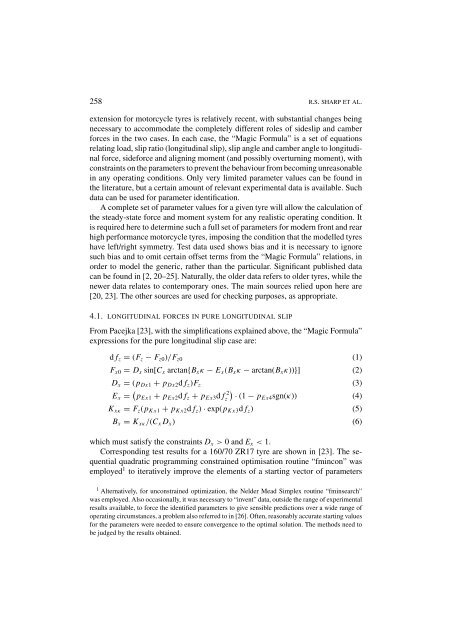Advances in the Modelling of Motorcycle Dynamics - ResearchGate
Advances in the Modelling of Motorcycle Dynamics - ResearchGate
Advances in the Modelling of Motorcycle Dynamics - ResearchGate
You also want an ePaper? Increase the reach of your titles
YUMPU automatically turns print PDFs into web optimized ePapers that Google loves.
258 R.S. SHARP ET AL.extension for motorcycle tyres is relatively recent, with substantial changes be<strong>in</strong>gnecessary to accommodate <strong>the</strong> completely different roles <strong>of</strong> sideslip and camberforces <strong>in</strong> <strong>the</strong> two cases. In each case, <strong>the</strong> “Magic Formula” is a set <strong>of</strong> equationsrelat<strong>in</strong>g load, slip ratio (longitud<strong>in</strong>al slip), slip angle and camber angle to longitud<strong>in</strong>alforce, sideforce and align<strong>in</strong>g moment (and possibly overturn<strong>in</strong>g moment), withconstra<strong>in</strong>ts on <strong>the</strong> parameters to prevent <strong>the</strong> behaviour from becom<strong>in</strong>g unreasonable<strong>in</strong> any operat<strong>in</strong>g conditions. Only very limited parameter values can be found <strong>in</strong><strong>the</strong> literature, but a certa<strong>in</strong> amount <strong>of</strong> relevant experimental data is available. Suchdata can be used for parameter identification.A complete set <strong>of</strong> parameter values for a given tyre will allow <strong>the</strong> calculation <strong>of</strong><strong>the</strong> steady-state force and moment system for any realistic operat<strong>in</strong>g condition. Itis required here to determ<strong>in</strong>e such a full set <strong>of</strong> parameters for modern front and rearhigh performance motorcycle tyres, impos<strong>in</strong>g <strong>the</strong> condition that <strong>the</strong> modelled tyreshave left/right symmetry. Test data used shows bias and it is necessary to ignoresuch bias and to omit certa<strong>in</strong> <strong>of</strong>fset terms from <strong>the</strong> “Magic Formula” relations, <strong>in</strong>order to model <strong>the</strong> generic, ra<strong>the</strong>r than <strong>the</strong> particular. Significant published datacan be found <strong>in</strong> [2, 20–25]. Naturally, <strong>the</strong> older data refers to older tyres, while <strong>the</strong>newer data relates to contemporary ones. The ma<strong>in</strong> sources relied upon here are[20, 23]. The o<strong>the</strong>r sources are used for check<strong>in</strong>g purposes, as appropriate.4.1. LONGITUDINAL FORCES IN PURE LONGITUDINAL SLIPFrom Pacejka [23], with <strong>the</strong> simplifications expla<strong>in</strong>ed above, <strong>the</strong> “Magic Formula”expressions for <strong>the</strong> pure longitud<strong>in</strong>al slip case are:d f z = (F z − F z0 )/F z0 (1)F x0 = D x s<strong>in</strong>[C x arctan{B x κ − E x (B x κ − arctan(B x κ))}] (2)D x = (p Dx1 + p Dx2 d f z )F z (3)E x = ( p Ex1 + p Ex2 d f z + p Ex3 d fz2 )· (1 − pEx4 sgn(κ)) (4)K xκ = F z (p Kx1 + p Kx2 d f z ) · exp(p Kx3 d f z ) (5)B x = K xκ /(C x D x ) (6)which must satisfy <strong>the</strong> constra<strong>in</strong>ts D x > 0 and E x < 1.Correspond<strong>in</strong>g test results for a 160/70 ZR17 tyre are shown <strong>in</strong> [23]. The sequentialquadratic programm<strong>in</strong>g constra<strong>in</strong>ed optimisation rout<strong>in</strong>e “fm<strong>in</strong>con” wasemployed 1 to iteratively improve <strong>the</strong> elements <strong>of</strong> a start<strong>in</strong>g vector <strong>of</strong> parameters1 Alternatively, for unconstra<strong>in</strong>ed optimization, <strong>the</strong> Nelder Mead Simplex rout<strong>in</strong>e “fm<strong>in</strong>search”was employed. Also occasionally, it was necessary to “<strong>in</strong>vent” data, outside <strong>the</strong> range <strong>of</strong> experimentalresults available, to force <strong>the</strong> identified parameters to give sensible predictions over a wide range <strong>of</strong>operat<strong>in</strong>g circumstances, a problem also referred to <strong>in</strong> [26]. Often, reasonably accurate start<strong>in</strong>g valuesfor <strong>the</strong> parameters were needed to ensure convergence to <strong>the</strong> optimal solution. The methods need tobe judged by <strong>the</strong> results obta<strong>in</strong>ed.
















